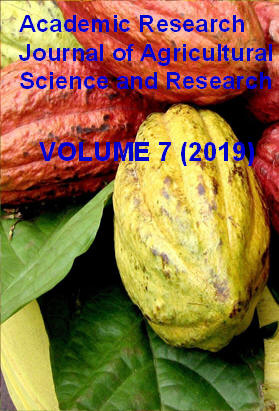| ARJASR |
Academic Research Journal of
Agricultural Science and Research |
|||||||||||||||||||
|
Vol. 7(2), pp. 63-74, March 2019 Full Length Research Effects of climate variability on development of wheat rust diseases (Puccinia spp.) and favorable weather condition for rusts in the highlands of Bale, Southeastern Ethiopia
Zerihun Dibaba Tufa1*
1Sinana Agricultural Research Center, Bale Robe, Ethiopia. Corresponding author*: zerihun.dibaba@gmail.com
Accepted 27 February 2019
Rainfall, temperature and relative humidity are the most important climatic parameters for agricultural practices and more conducive for disease and insect developments. In this study, effects of climate variability on development wheat rust diseases and favorable weather condition for rust were analyzed. Cropping season weather data obtained from nearby stations were used to analysis impacts on rust disease occurrence. The result of historical data analysis suggested that, annual rainfall amount was increased by 9.1 mm/yr and 2.8 mm/yr at Sinana and Robe respectively. On the other hand, the seasonal kiremt rain was increased by 6.1 mm/yr at Sinana station and 2.9 mm/yr at Robe station. The study results revealed that climate variability has played a great role in agricultural practices, which in turn influences crop diseases occurrence. In particular, it has induced wheat rust diseases over the study areas that significantly affect the quality and quantity of the yield. The correlation between monthly rainfalls and disease severity about -0.86, while for relative humidity and diseases severity reached 0.74 at (p= 0.05). This condition was also true for maximum and minimum temperature with rust diseases, the correlation analysis indicated 0.61 and 0.79 respectively (p=0.05). From weekly analysis during cropping season, the climatic condition conducive for rust diseases occurrence were identified. Therefore, the development and spread of rust is highly enhanced with maximum temperature and minimum temperature ranges 20.8 oC to 28 oC and 8.2 oC to 11.7 oC , while relative humidity was more than 70 % across the highland regions. In view of this condition, early warning can be well practiced by acquiring appropriate lead-time climate-based forecasting of on the possible occurrence of both climates and diseases on varieties of wheat crops across the Bale highlands.
Key words: Climate variability, wheat rust, disease, variety.
How to cite this article (APA Style): Zerihun, D.T. (2019). Effects of climate variability on wheat rust (Puccinia spp.) diseases and climatic condition conducive for rust in the highlands of Bale, Southeastern Ethiopia. Acad. Res. J. Agri. Sci. Res. 7(2): 63-74
|
|||||||||||||||||||
